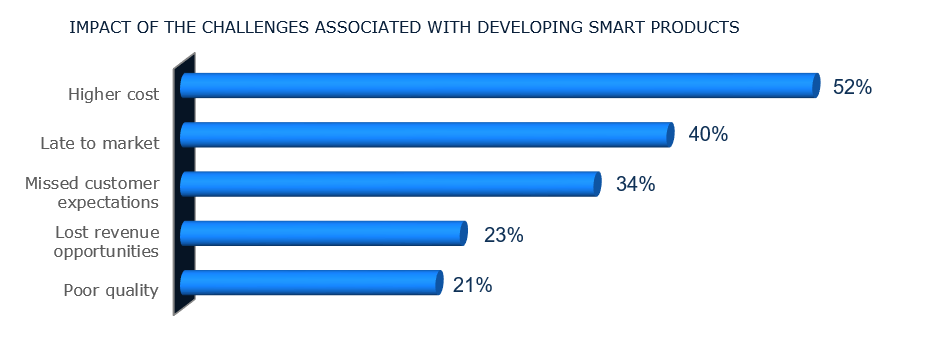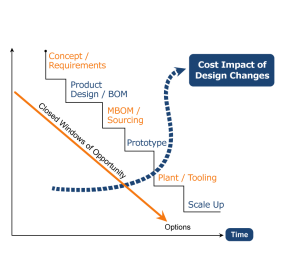How are your engineers managing increasing product complexity?
Staying Competitive Has Led to Increased Complexity
Competition is fierce for today’s manufacturers as they seek to win market share from both traditional competitors and emerging start-ups, often at a global level. Consequently, product engineering and innovation play a crucial role in competitive differentiation. Innovation opportunities range from smarter features to new service offerings, which require increases in software, electronics, connectivity, sensors, components, and more. In fact, a Tech-Clarity study, Transformational Product Design: How to Achieve Success Designing Smarter Products, found that 71% of survey respondents report feeling pressure to add more software and electronics.
While this is a powerful way to attract customers, it increases product complexity, making an engineer’s job even more challenging. Tech-Clarity’s research study, How to Engineer High-Performing, Quality Products with Extra Cost, finds that 67% of survey respondents say complexity has grown over the last five years, and 44% find it’s even harder to make critical design decisions. Yet, Top Performers are 58% more likely than their competitors to be confident in their decisions. These results show that while the job may be getting harder, there are practices that will help.
However, getting it wrong is expensive. Companies that don’t make it easier for engineers will suffer negative consequences.
What Causes This Business Impact?

With increasing complexity complicating engineering decisions, there’s a greater risk for errors. The earlier you find problems, the less expensive they are to fix (see graphic).
Early in the design cycle, there’s lots of flexibility to try out different ideas, optimize the architecture and design, and make changes. However, as the design evolves, more becomes solidified, and changes begin to impact other parts of the design. As more components become impacted, changes consume more time. It’s also harder to identify all the impacts. Missing anything can result in costly errors and quality issues. Then, when you order steel and engage suppliers, any change can result in scrap, which further drives up costs. Also, solutions are more restricted for late-stage problems. Rather than an optimal solution, the team is forced to do what’s easiest and fastest, potentially compromising quality and adding even more time and cost.
The more engineers can do upfront to optimize the system architecture, verify and validate requirements, and identify potential problems, the better. It will save time, lower costs, and improve quality.
New Approaches Needed
With expectations for continually increasing product complexity, these issues will only become harder. Consequently, companies need to adopt new engineering approaches to avoid these risks. Those who do not are more likely to find themselves at a competitive disadvantage as their peers adopt more successful practices.
These trends have driven many companies, especially those in the automotive, and aerospace & defense industries, to adopt systems engineering best practices. However, traditional systems engineering practices tend to be document-based, limiting the benefits. This has led many to adopt Model-based Systems Engineering (MBSE).
What Is MBSE?
The INCOSE Systems Engineering (SE) Vision 2020 defines MBSE as the formalized application of modeling to support system requirements, design, analysis, and verification and validation activities, beginning in the conceptual design phase and continuing throughout development and later life cycle phases. The system model becomes the “hub” for the design.
How Does MBSE Help?
Consider for a moment the top challenges of systems engineering. Designing a system involves bringing together multiple disciplines including mechanical, electrical, and software. Each has specialized tools and processes, which create silos, complicating collaboration across disciplines. A document-centric approach reinforces those silos. Since documents lack intelligence, engineers across disciplines often struggle with visibility into aspects of the design that impact them. With a model at the center, visualizing design intent becomes easier across disciplines, improving collaboration.
Verifying requirements are met is also challenging. A document-based approach lacks traceability across requirements, making it hard to
identify dependencies and change impacts. An intelligent model will provide this traceability and links the requirements to design artifacts. In addition, the model will automatically update to reflect all changes.
System complexity also complicates predicting system-level behavior and identifying problems early. With a system model that integrates simulation, analysis, and analytics, system architects can evaluate different system configurations more easily to make better decisions around optimization and requirements. It will also be easier to predict system behavior to debug the architecture early on and quickly identify problems continuously throughout the development lifecycle.
Considering all of this, an MBSE tool that brings together requirements, PLM, CAD, analysis, embedded software development, and electronics can be incredibly powerful. Moreover, it can offer new levels of engineering insight to reduce risk and help develop quality systems on schedule and on budget.
September 21 Discussion of MBSE as the Unsung Technology Hero
To learn more about this exciting topic, please join me on September 21 at 1:00 EDT for an interactive panel discussion. Among other issues, we will discuss how to justify MBSE and share advice to implement it. I hope you can join us.
##
Editor:
To learn more about digital transformation strategies, register here for the 3DEXPERIENCE Dialogues – our focused topic roundtables taking place Sept. 21-23 featuring influencers and customers focused on complex challenges, future outlook, and practical solutions for post-pandemic innovation, including:
- Sept. 21: The Unsung Technology Hero behind Product Innovation.
- Sept. 22: Digital Transformation-Where Do We Go From Here?
- Sept. 23: How Manufacturing Success starts with Virtual + Real Operations.

